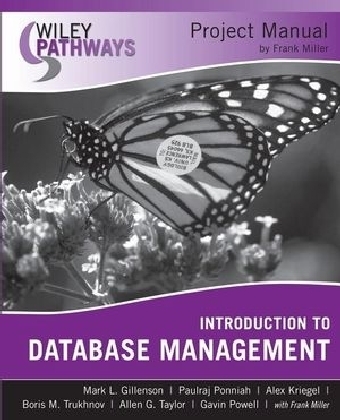
Wiley Pathways Introduction to Database Management, Project Manual
John Wiley & Sons Inc (Verlag)
978-0-470-11410-0 (ISBN)
You can get there
Introduction to Databases Project Manual offers a wealth of easy-to-read, practical, up-to-date activities that reinforce fundamental database design and management concepts. You'll also learn to develop the core competencies and skills you'll need in the real world, such as how to:
* Install SQL Server 2005
* Read and create an ERD
* Design and implement a database
* Use DDL and DML commands
* Use and monitor transactions
* Manage security principles, permissions, and backups
* Design data environments
* Use replication
With five to seven projects per chapter ranging from easy to more advanced, Introduction to Databases Project Manual is ideal for both traditional and online courses that are oriented toward strengthening database management skills.
Introduction to Databases Project Manual is an excellent companion to Gillenson's Introduction to Databases (ISBN: 978-0-470-10186-5).
Wiley Pathways helps you achieve your goals
Not every student is on the same path, but every student wants to succeed. The Information Technology series in the new Wiley Pathways imprint helps you achieve your goals. The books and project manuals in this series--Introduction to Databases, Introduction to Programming Using Visual Basic, Introduction to Operating Systems, Networking Basics, Windows Network Administration, Network Security Fundamentals, and PC Hardware Essentials--offer a coordinated information technology curriculum. Learn more at www.wiley.com/go/pathways.
Dr. Mark L. Gillenson has been practicing, researching, teaching, writing, and, most importantly, thinking, about data and database management for over twenty-five years, split between working for the IBM Corporation and being a professor in the academic world. While working for IBM, he designed databases for IBM's corporate headquarters, consulted on database issues for some of IBM's largest customers, taught database management at the prestigious IBM Systems Research Institute in New York, and conducted database seminars throughout the United States and on four continents. In one such seminar, he taught introduction to database to an IBM development group that went on to develop one of IBM's first relational database management system products, SQL/DS. Frank Miller has nearly 30 years experience designing, developing, and delivering technical training materials. For 20 of those years, SQL language database management systems have been an area of special interest and expertise. During that time he has written books and other training materials that are used by various schools and professional organizations in the United States and around the world.
1 Introduction to Data and Data Management
1.1 Identifying Business Data 2
1.2 Identifying Human Data Sources 4
1.3 Installing SQL Server 2005 Evaluation Edition 5
1.4 Learning about SQL Server Management Studio 12
1.5 Identifying Key Management Areas 19
2 Introducing Databases and Database Management Systems
2.1 Comparing Database Models 21
2.2 Identifying DBMS Architecture and Components 23
2.3 Reviewing Server Hardware Resources 24
2.4 Investigating SQL Server Databases 32
2.5 Identifying Application Requirements 35
3 Data Modeling
3.1 Understanding Data Modeling Concepts 39
3.2 Recognizing Entities, Attributes, and Identifiers 40
3.3 Recognizing Relationships and Business Rules 42
3.4 Reading an ERD 45
3.5 Creating an ERD 47
3.6 Viewing Basic Database Objects 50
4 Designing a Database
4.1 Understanding Key Concepts 59
4.2 Converting Relationships 60
4.3 Reviewing a Normalized Database 65
4.4 Recognizing Normalization Errors 69
4.5 Normalizing Data 73
5 Implementing a Database
5.1 Understanding Terms and Concepts 78
5.2 Identifying Solution Requirements 79
5.3 Creating a Database 84
5.4 Creating Tables, Part 1 88
5.5 Setting Table Constraints 91
5.6 Creating Tables, Part 2 96
6 Understanding the SQL Language
6.1 Understanding Terms and Concepts 102
6.2 Identifying Help Resources 104
6.3 Comparing Command Environments 111
6.4 Using the SELECT Command 116
6.5 Using DDL Commands 121
6.6 Using DML Commands 126
7 Data Access and Manipulation
7.1 Understanding Data Access 132
7.2 Retrieving Data 133
7.3 Using Advanced Data Retrieval 138
7.4 Using Batches and Scripts 141
7.5 Recognizing and Correcting Syntax Errors 144
8 Improving Data Access
8.1 Understanding Database Monitoring and Optimization 149
8.2 Investigating Resources and Configuration Settings 151
8.3 Monitoring Performance 163
8.4 Recognizing Bottlenecks 172
8.5 Using Indexes and Views 175
8.6 Using Procedures and Functions 179
9 Database Administration
9.1 Understanding Administration 184
9.2 Understanding Roles and Responsibilities 186
9.3 Matching Life Cycle Requirements 188
9.4 Resolving Administration Issues 190
9.5 Managing "As-Needed" and Periodic Tasks 196
10 Transactions and Locking
10.1 Understanding Transactions and Locking 210
10.2 Understanding Transaction Types 212
10.3 Understanding Transaction Isolation and Locking 219
10.4 Using Transactions 226
10.5 Monitoring Transactions and Clearing Blocked Transactions 231
11 Data Access and Security
11.1 Understanding Data Access and Security 236
11.2 Designing for Access and Security 238
11.3 Understanding Your Security Environment 242
11.4 Managing Security Principals 249
11.5 Managing Permissions 255
11.6 Managing Backups 263
12 Supporting Database Applications
12.1 Understanding Data Configurations 267
12.2 Designing Data Environments 269
12.3 Working in a Distributed Environment 277
12.4 Using Distributed Queries 284
12.5 Using Replication 291
12.6 Understanding Data Issues 299
| Erscheint lt. Verlag | 4.5.2007 |
|---|---|
| Reihe/Serie | Wiley Pathways |
| Verlagsort | New York |
| Sprache | englisch |
| Maße | 216 x 277 mm |
| Gewicht | 612 g |
| Einbandart | Paperback |
| Themenwelt | Mathematik / Informatik ► Informatik ► Datenbanken |
| Informatik ► Office Programme ► Outlook | |
| ISBN-10 | 0-470-11410-X / 047011410X |
| ISBN-13 | 978-0-470-11410-0 / 9780470114100 |
| Zustand | Neuware |
| Informationen gemäß Produktsicherheitsverordnung (GPSR) | |
| Haben Sie eine Frage zum Produkt? |
aus dem Bereich


